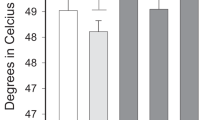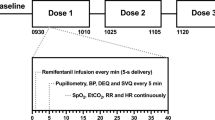Abstract
Rationale
Tapentadol is a novel analgesic that activates mu-opioid receptors and blocks norepinephrine reuptake. There is very little information available regarding the non-analgesic pharmacodynamic effects of tapentadol.
Objectives
This outpatient study evaluated the physiological, subject-rated, and performance effects of therapeutic doses of tapentadol compared to two control drugs in humans.
Methods
This double-blind, within-subject study examined the effects of oral placebo, tapentadol (25, 50, and 75 mg), tramadol (50, 100, and 150 mg), and hydromorphone (2, 4, and 6 mg). Nine occasional opioid users completed the study. Pharmacodynamic drug effects were measured before and for 6 h after drug administration.
Results
All three doses of the tested drugs produced comparable, time-dependent decreases in pupil diameter, but the effects were generally not dose dependent. The high dose of tapentadol, as well as all three doses of tramadol and hydromorphone, increased positive subject-rated effects (e.g., “Good Effects” and “Like the Drug”) as a function of time. Only tramadol increased negative subject-rated effects (e.g., “Bad Effects” and “Nauseous”); however, these were of low magnitude.
Conclusions
The highest tested dose of tapentadol produced a profile of positive effects comparable to that of hydromorphone, whereas tramadol produced positive and negative subject-rated effects. The mixed findings for tramadol are consistent with previous findings indicating that it has a distinct profile of effects relative to prototypic opioids. Future research should examine the effects of higher tapentadol doses, as well as the factors contributing to the different subject-rated profile of effects observed for tramadol relative to tapentadol and hydromorphone.


Similar content being viewed by others
References
Abreu ME, Bigelow GE, Fleisher L, Walsh SL (2001) Effect of intravenous injection speed on responses to cocaine and hydromorphone in humans. Psychopharmacology (Berl) 154:76–84
Afilalo M, Stegmann JU, Upmalis D (2010) Tapentadol immediate release: a new treatment option for acute pain management. J Pain Res 3:1–9
Australian Therapeutic Goods Association (2011) Australian public assessment report for tapentadol. www.tga.gov.au/pdf/auspar/auspar-palexia.pdf. Accessed 11 October 2012.
Babalonis S, Lofwall MR, Nuzzo PA, Siegel AJ, Walsh SL (2012) Abuse liability and reinforcing efficacy of oral tramadol in humans. Drug Alcohol Depend. doi:10.1016/j.drugalcdep.2012.09.018
Beaulieu AD, Peloso P, Bensen W, Clark AJ, Watson CP, Gardner-Nix J, Thomson G, Piraino PS, Eisenhoffer J, Harsanyi Z, Darke AC (2007) A randomized, double-blind, 8-week crossover study of once-daily controlled-release tramadol versus immediate-release tramadol taken as needed for chronic noncancer pain. Clin Ther 29:49–60
Comer SD, Ashworth JB, Sullivan MA, Vosburg SK, Saccone PA, Foltin RW (2009) Relationship between rate of infusion and reinforcing strength of oxycodone in humans. J Opioid Manag 5:203–212
Duke AN, Bigelow GE, Lanier RK, Strain EC (2011) Discriminative stimulus effects of tramadol in humans. J Pharmacol Exp Ther 338:255–262
Epstein DH, Preston KL, Jasinski DR (2006) Abuse liability, behavioral pharmacology and physical-dependence potential of opioids in humans and laboratory animals: lessons from tramadol. Biol Psychol 73:90–99
Frampton JE (2010) Tapentadol immediate release: a review of its use in the treatment of moderate to severe acute pain. Drugs 70:1719–1743
Grosset AB, Roberts MS, Woodson ME, Shi M, Swanton RE, Reder RF, Buckley BJ (2005) Comparative efficacy of oral extended-release hydromorphone and immediate-release hydromorphone in patients with persistent moderate to severe pain: two randomized controlled trials. J Pain Symptom Manage 29:584–594
Heil SH, Holmes HW, Bickel WK, Higgins ST, Badger GJ, Laws HF, Faries DE (2002) Comparison of the subjective, physiological and psychomotor effects of atomoxetine and methylphenidate in light drug users. Drug Alcohol Depend 67:149–156
Jasinski DR, Faries DE, Moore RJ, Schuh LM, Allen AJ (2008) Abuse liability assessment of atomoxetine in a drug-abusing population. Drug Alcohol Depend 95:140–146
Kollins SH, Rush CR, Pazzaglia PJ, Ali JA (1998) Comparison of acute behavioral effects of sustained-release and immediate-release methylphenidate. Exp Clin Psychopharmacol 6:367–374
Lile JA, Kelly TH, Hays LR (2010) The reinforcing, self-reported performance and physiological effects of Delta9-tetrahydrocannabinol, triazolam, hydromorphone, and methylphenidate in cannabis users. Behav Pharmacol 21:29–38
Lile JA, Kelly TH, Pinsky DJ, Hays LR (2009) Substitution profile of Delta9-tetrahydrocannabinol, triazolam, hydromorphone, and methylphenidate in humans discriminating Delta9-tetrahydrocannabinol. Psychopharmacology (Berl) 203:241–250
Lofwall MR, Walsh SL, Bigelow GE, Strain EC (2007) Modest opioid withdrawal suppression efficacy of oral tramadol in humans. Psychopharmacology 194:381–393
McLeod D, Griffiths RR, Bigelow GE, Yingling J (1982) An automated version of the digit symbol substitution test (DSST). Behav Res Meth Ins 14:433–436
Nossaman VE, Ramadhyani U, Kadowitz PJ, Nossaman BD (2010) Advances in perioperative pain management: use of medications with dual analgesic mechanisms, tramadol & tapentadol. Anesthesiol Clin 28:647–666
Raffa RB, Buschmann H, Christoph T, Eichenbaum G, Englberger W, Flores CM, Hertrampf T, Kögel B, Schiene K, Straßburger W, Terlinden R, Tzschentke TM (2012) Mechanistic and functional differentiation of tapentadol and tramadol. Expert Opin Pharmacother 13:1437–1449
Riemsma R, Forbes C, Harker J, Worthy G, Misso K, Schäfer M, Kleijnen J, Stürzebecher S (2011) Systematic review of tapentadol in chronic severe pain. Curr Med Res Opin 27:1907–1930
Schröder W, Vry JD, Tzschentke TM, Jahnel U, Christoph T (2010) Differential contribution of opioid and noradrenergic mechanisms of tapentadol in rat models of nociceptive and neuropathic pain. Eur J Pain 14:814–821
Sharm MJ, Sathyan G, Khanna S, Tudor IC, Nath R, Thippawhong J, Sellers EM (2010) Evaluation of the abuse potential of extended release hydromorphone versus immediate release hydromorphone. J Clin Psychopharmacol 30:25–33
Stoops WW, Hatton KW, Lofwall MR, Nuzzo PA, Walsh SL (2010) Intravenous oxycodone, hydrocodone and morphine in recreational opioid users: abuse potential and relative potencies. Psychopharmacology 212:193–203
Stoops WW, Lofwall MR, Nuzzo PA, Craig LB, Siegel AJ, Walsh SL (2012) Pharmacodynamic profile of tramadol in humans: Influence of naltrexone pretreatment. Psychopharmacology 223:427–438
Tzschentke TM, Christoph T, Kögel B, Schiene K, Hennies HH, Englberger W, Haurand M, Jahnel U, Cremers TI, Friderichs E, De Vry J (2007) (−)-(1R,2R)-3-(3-dimethylamino-1-ethyl-2-methyl-propyl)-phenol hydrochloride (tapentadol HCl): a novel mu-opioid receptor agonist/norepinephrine reuptake inhibitor with broad-spectrum analgesic properties. J Pharmacol Exp Ther 323:265–276
Tzschentke TM, Folgering JH, Flik G, De Vry J (2012) Tapentadol increases levels of noradrenaline in the rat spinal cord as measured by in vivo microdialysis. Neurosci Lett 507:151–155
Vanderkooy JD, Kennedy SH, Bagby RM (2002) Antidepressant side effects in depression patients treated in a naturalistic setting: a study of bupropion, moclobemide, paroxetine, sertraline and venlafaxine. Can J Psychiatry 47:174–180
Walsh SL, Nuzzo PA, Lofwall MR, Holtman JR Jr (2008) The relative abuse liability of oral oxycodone, hydrocodone and hydromorphone assessed in prescription opioid abusers. Drug Alcohol Depend 98:191–202
Zacny JP (2005) Profiling the subjective, psychomotor and physiological effects of tramadol in recreational drug users. Drug Alcohol Depend 80:273–278
Acknowledgments
This research was supported by grant number R01DA025649 from the National Institute on Drug Abuse (PI, William W. Stoops) and by departmental start-up funds awarded to William W. Stoops. The content is solely the responsibility of the authors and does not necessarily represent the official views of NIDA or NIH. The authors wish to thank the staff at the University of Kentucky Laboratory of Human Behavioral Pharmacology for their technical and medical assistance.
Conflict of interest
The authors declare no conflicts of interest relevant to this project.
Author information
Authors and Affiliations
Corresponding author
Electronic Supplementary Materials
Below is the link to the electronic supplementary material.
ESM 1
(PDF 35 kb)
Rights and permissions
About this article
Cite this article
Stoops, W.W., Glaser, P.E.A. & Rush, C.R. Miotic and subject-rated effects of therapeutic doses of tapentadol, tramadol, and hydromorphone in occasional opioid users. Psychopharmacology 228, 255–262 (2013). https://doi.org/10.1007/s00213-013-3031-y
Received:
Accepted:
Published:
Issue Date:
DOI: https://doi.org/10.1007/s00213-013-3031-y




